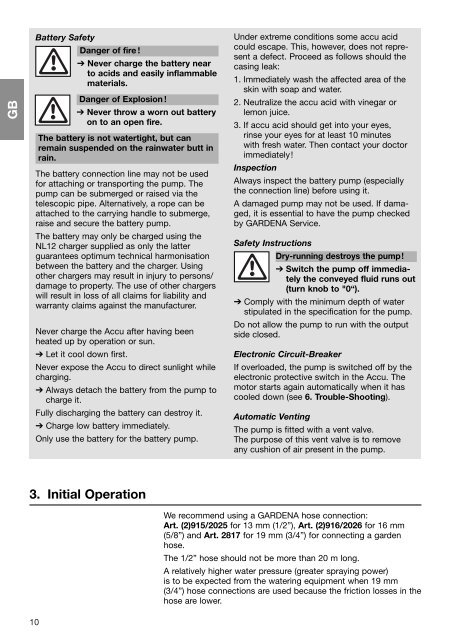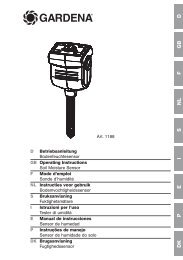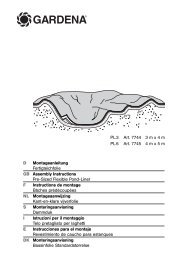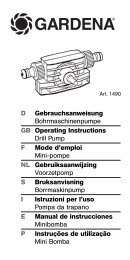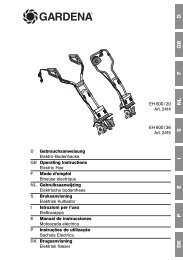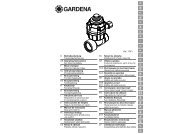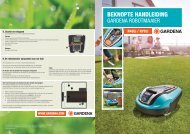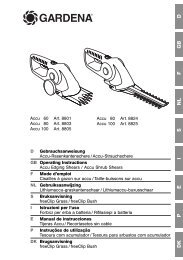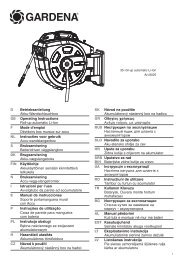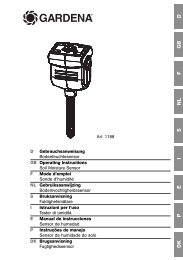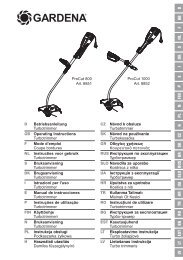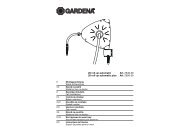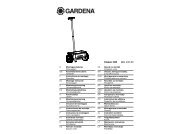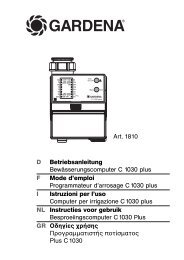OM, Gardena, Battery Pump, Art 01498-20, 2003-06
OM, Gardena, Battery Pump, Art 01498-20, 2003-06
OM, Gardena, Battery Pump, Art 01498-20, 2003-06
Create successful ePaper yourself
Turn your PDF publications into a flip-book with our unique Google optimized e-Paper software.
GB<br />
10<br />
<strong>Battery</strong> Safety<br />
Danger of fire !<br />
➔ Never charge the battery near<br />
to acids and easily inflammable<br />
materials.<br />
Danger of Explosion !<br />
➔ Never throw a worn out battery<br />
on to an open fire.<br />
The battery is not watertight, but can<br />
remain suspended on the rainwater butt in<br />
rain.<br />
The battery connection line may not be used<br />
for attaching or transporting the pump. The<br />
pump can be submerged or raised via the<br />
telescopic pipe. Alternatively, a rope can be<br />
attached to the carrying handle to submerge,<br />
raise and secure the battery pump.<br />
The battery may only be charged using the<br />
NL12 charger supplied as only the latter<br />
guarantees optimum technical harmonisation<br />
between the battery and the charger. Using<br />
other chargers may result in injury to persons/<br />
damage to property. The use of other chargers<br />
will result in loss of all claims for liability and<br />
warranty claims against the manufacturer.<br />
Never charge the Accu after having been<br />
heated up by operation or sun.<br />
➔ Let it cool down first.<br />
Never expose the Accu to direct sunlight while<br />
charging.<br />
➔ Always detach the battery from the pump to<br />
charge it.<br />
Fully discharging the battery can destroy it.<br />
➔ Charge low battery immediately.<br />
Only use the battery for the battery pump.<br />
3. Initial Operation<br />
Under extreme conditions some accu acid<br />
could escape. This, however, does not represent<br />
a defect. Proceed as follows should the<br />
casing leak:<br />
1. Immediately wash the affected area of the<br />
skin with soap and water.<br />
2. Neutralize the accu acid with vinegar or<br />
lemon juice.<br />
3. If accu acid should get into your eyes,<br />
rinse your eyes for at least 10 minutes<br />
with fresh water. Then contact your doctor<br />
immediately!<br />
Inspection<br />
Always inspect the battery pump (especially<br />
the connection line) before using it.<br />
A damaged pump may not be used. If damaged,<br />
it is essential to have the pump checked<br />
by GARDENA Service.<br />
Safety Instructions<br />
Dry-running destroys the pump!<br />
➔ Switch the pump off immediately<br />
the conveyed fluid runs out<br />
(turn knob to "0“).<br />
➔ Comply with the minimum depth of water<br />
stipulated in the specification for the pump.<br />
Do not allow the pump to run with the output<br />
side closed.<br />
Electronic Circuit-Breaker<br />
If overloaded, the pump is switched off by the<br />
electronic protective switch in the Accu. The<br />
motor starts again automatically when it has<br />
cooled down (see 6. Trouble-Shooting).<br />
Automatic Venting<br />
The pump is fitted with a vent valve.<br />
The purpose of this vent valve is to remove<br />
any cushion of air present in the pump.<br />
We recommend using a GARDENA hose connection:<br />
<strong>Art</strong>. (2)915/<strong>20</strong>25 for 13 mm (1/2”), <strong>Art</strong>. (2)916/<strong>20</strong>26 for 16 mm<br />
(5/8”) and <strong>Art</strong>. 2817 for 19 mm (3/4”) for connecting a garden<br />
hose.<br />
The 1/2” hose should not be more than <strong>20</strong> m long.<br />
A relatively higher water pressure (greater spraying power)<br />
is to be expected from the watering equipment when 19 mm<br />
(3/4”) hose connections are used because the friction losses in the<br />
hose are lower.


